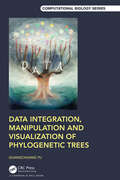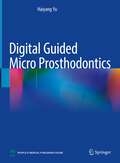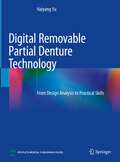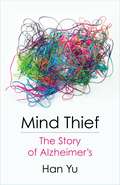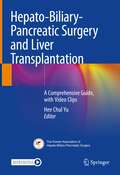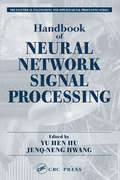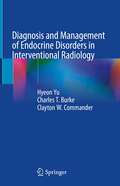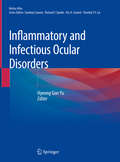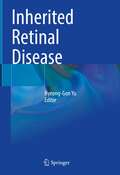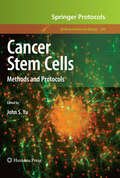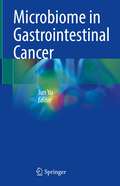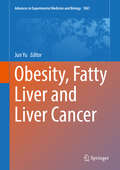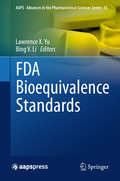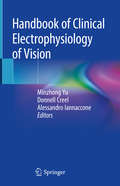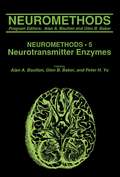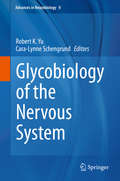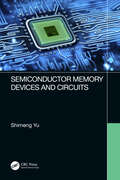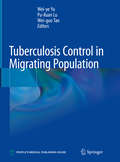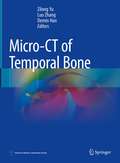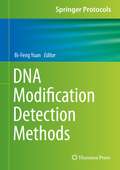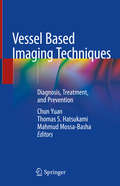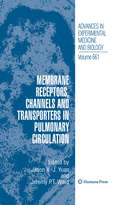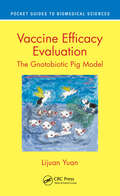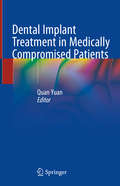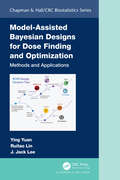- Table View
- List View
Data Integration, Manipulation and Visualization of Phylogenetic Trees (Chapman & Hall/CRC Computational Biology Series)
by Guangchuang YuData Integration, Manipulation and Visualization of Phylogenetic Trees introduces and demonstrates data integration, manipulation and visualization of phylogenetic trees using a suite of R packages, tidytree, treeio, ggtree and ggtreeExtra. Using the most comprehensive packages for phylogenetic data integration and visualization, contains numerous examples that can be used for teaching and learning. Ideal for undergraduate readers and researchers with a working knowledge of R and ggplot2. Key Features: Manipulating phylogenetic tree with associated data using tidy verbs Integrating phylogenetic data from diverse sources Visualizing phylogenetic data using grammar of graphics
Digital Guided Micro Prosthodontics
by Haiyang YuThis book focuses on the clear and simplified clinical techniques for microscopic restoration dentistry. With the help of microscope and hole reference technique (HRT), dentists can design the dimensional relationship and carry it out in preparation precisely. Authors firstly introduce an overview and surgical microscope and auxiliary instruments. In the second part, there are 4 techniques shown in each chapter.
Digital Removable Partial Denture Technology: From Design Analysis to Practical Skills
by Haiyang YuThis book introduces esthetic clasp as an innovative method that improves the appearance of clasps by changing the clasp design. It details the concept of esthetic clasp, the classification of esthetic clasp design methods, the clinical pathway of esthetic clasp techniques, many selected cases, and the logos of different kinds of esthetic clasps. This book is suitable for all professional dentists, dental technicians and students.
Mind Thief: The Story of Alzheimer's
by Han YuAlzheimer’s disease, a haunting and harrowing ailment, is one of the world’s most common causes of death. Alzheimer’s lingers for years, with patients’ outward appearance unaffected while their cognitive functions fade away. Patients lose the ability to work and live independently, to remember and recognize. There is still no proven way to treat Alzheimer’s because its causes remain unknown.Mind Thief is a comprehensive and engaging history of Alzheimer’s that demystifies efforts to understand the disease. Beginning with the discovery of “presenile dementia” in the early twentieth century, Han Yu examines over a century of research and controversy. She presents the leading hypotheses for what causes Alzheimer’s; discusses each hypothesis’s tangled origins, merits, and gaps; and details their successes and failures. Yu synthesizes a vast amount of medical literature, historical studies, and media interviews, telling the gripping stories of researchers’ struggles while situating science in its historical, social, and cultural contexts. Her chronicling of the trajectory of Alzheimer’s research deftly balances rich scientific detail with attention to the wider implications. In narrating the attempts to find a treatment, Yu also offers a critical account of research and drug development and a consideration of the philosophy of aging. Wide-ranging and accessible, Mind Thief is an important book for all readers interested in the challenge of Alzheimer’s.
Hepato-Biliary-Pancreatic Surgery and Liver Transplantation: A Comprehensive Guide, with Video Clips
by Hee Chul YuThis book describes and illustrates surgical procedures in the field of hepatobiliary and pancreatic surgery and liver transplantation, including important cutting-edge techniques. Written by master surgeons from the Korean Association of Hepato-Biliary-Pancreatic Surgery, it will be invaluable for all who are embarking on a career in this field or are seeking to improve their surgical skills. The three sections of the book focus on liver surgery, gallbladder and biliary surgery, and pancreatic surgery. A wide range of operative procedures are covered, including different techniques of hepatectomy, deceased and living donor liver transplantation, cholecystectomy, resection of choledochal cysts, procedures appropriate in the contexts of hilar and extrahepatic cholangiocarcinoma, pancreatectomy, and pancreaticoduodenectomy. Attention is drawn to essential tips and tricks, and each chapter includes video clips of the described procedures in addition to high-quality surgical photos and illustrations.
Handbook of Neural Network Signal Processing (Electrical Engineering & Applied Signal Processing Series)
by YU HEN HU AND JENQ-NENG HWANGThe use of neural networks is permeating every area of signal processing. They can provide powerful means for solving many problems, especially in nonlinear, real-time, adaptive, and blind signal processing. The Handbook of Neural Network Signal Processing brings together applications that were previously scattered among various publications to provide an up-to-date, detailed treatment of the subject from an engineering point of view.The authors cover basic principles, modeling, algorithms, architectures, implementation procedures, and well-designed simulation examples of audio, video, speech, communication, geophysical, sonar, radar, medical, and many other signals. The subject of neural networks and their application to signal processing is constantly improving. You need a handy reference that will inform you of current applications in this new area. The Handbook of Neural Network Signal Processing provides this much needed service for all engineers and scientists in the field.
Diagnosis and Management of Endocrine Disorders in Interventional Radiology
by Hyeon Yu Charles T. Burke Clayton W. CommanderThis book provides a comprehensive guide for selective venous sampling procedures and the role of interventional radiologists in the care and treatment of patients with endocrine disorders. Disorders of the endocrine system involve an imbalance in the natural homeostasis of the hormones produced by the glands in the body. There are a variety of endocrine conditions that are characterized by either hormonal hyposecretion or hypersecretion. Percutaneous selective venous sampling is the gold standard diagnostic tool for the medical and surgical management of patients with a variety of such disorders. Selective venous sampling is a minimally invasive interventional procedure that interventional radiologists perform to localize sites of abnormal hormone secretion. Computed tomography and magnetic resonance imaging are the most used diagnostic imaging modalities in patients with the suspected endocrine disorder; however, their specificity is not optimal, and identifying a culprit gland is difficult based on imaging findings alone. Therefore, the ultimate decision for management depends on the outcome of selective venous sampling. As these various venous samplings are increasingly performed worldwide, the collaboration between interventional radiology, endocrinology, surgical endocrinology, surgical oncology, neurosurgery, and gynecology teams is essential. With limited literature on the topic, this volume fills the gap with in-depth coverage of selective venous sampling alongside the pathophysiology, epidemiology, clinical diagnosis, as well as medical, surgical, and interventional management of endocrine disorders. The book is divided into five parts: Clinical, Laboratory, and Radiological Diagnosis of Endocrine Disorders; Selective Venous Sampling in Interventional Radiology; Medical Treatment of Endocrine Disorders; Surgical Treatment of Endocrine Disorders; Interventional Treatment of Endocrine Disorders. Throughout these parts, endocrine disorders that require venous sampling are covered in depth: primary aldosteronism, primary hyperparathyroidism, Cushing’s disease, hormone-secreting pancreatic adenomas, and androgen-secreting ovarian tumors. There is additionally an emerging role for interventional management in thyroid gland disorders, which is covered here. This is an ideal guide for interventional radiologists caring for patients with endocrine disorders, as well as endocrinologists, endocrine surgeons, surgical oncologists, otolaryngologists, neurosurgeons, gynecologists, and nephrologists.
Inflammatory and Infectious Ocular Disorders (Retina Atlas)
by Hyeong Gon YuThis atlas covers most ocular inflammatory and infectious diseases of importance with clinical significance. It includes chapters on non-infectious diseases and chapters on infectious diseases. For each chapter, essential information regarding the clinical features, diagnosis, and management is described in the text based on the up-to-date knowledge, and more than 240 carefully selected photographs are provided. World-famous experts in this field have included as many as valuable photographs of patients as possible. New imaging tests of ultra-wide field retinal images and high-resolution optical coherence tomography are included in addition to conventional fundus photos and fluorescein angiographs. Especially, chapters on infectious diseases provide invaluable photos of rare but clinically important diseases. Designed to assist in the diagnosis and treatment of ocular inflammation and infection, this book is meant for the retina specialist, researchers of ocular inflammation, general ophthalmologist, resident and retina fellow. Inflammatory and Infectious Ocular Disorders atlas is one of the nine volumes of the series Retina Atlas. This series provides global perspective on vitreoretinal diseases, covering imaging basics, retinal vascular disease, macular disorders, ocular inflammatory and infectious disorders, retinal degeneration, surgical retina, ocular oncology, pediatric retina and trauma. This comprehensive atlas is spread over 9 volumes and about 100 chapters, covering validated and comprehensive information on retinal disorders.
Inherited Retinal Disease
by Hyeong-Gon YuThis book presents the latest knowledge and expert guidance on all aspects of inherited retinal diseases, including molecular genetics, diagnosis, clinical features, general principles of treatment, novel treatment methods, and genetic counseling. Recent years have witnessed great advances in understanding of the genetic and cytological background of these diseases. Genetic analysis methods such as next generation sequencing have remarkably reduced the cost and time required for massive analysis of patients’ samples. Studies on gene therapy and stem cell therapy have been successfully carried out in animal models, and gene therapy is now available for Leber congenital amaurosis caused by RPE65 mutations. Against this background, Inherited Retinal Disease will be an invaluable up-to-date resource for ophthalmologists, medical students, and researchers in ocular inflammation. In addition to supplying essential information on each individual disorder, it features many interesting cases contributed by global leaders in the field as well as clinical photographs obtained with newer imaging techniques and numerous images of rare but clinically important diseases.
Cancer Stem Cells: Methods and Protocols (Methods in Molecular Biology #568)
by John S. YuThrough the revolutionary concept of cancer stem cells, cancer research has been reinvigorated to study the role of these unique cells in cancer propagation and as targets of innovative therapies. In Cancer Stem Cells: Methods and Protocols, preeminent researchers have compiled cancer stem cell research techniques and protocols to promote healthy competition, discourse, and collaboration in this vital field. The volume covers extensive topics such as identification and isolation of cancer stem cells, animal models of cancer stem cells, methylation profiling, the contribution of the niche in the regulation of cancer stem cells, immunologic targeting, and the use of normal stem cells as a treatment, among other subjects. Written in the highly successful Methods in Molecular BiologyTM series format, chapters include brief introductions to their respective topics, lists of the necessary materials and reagents, step-by-step, readily reproducible laboratory protocols, and expert notes on troubleshooting and avoiding known pitfalls. Comprehensive and cutting-edge, Cancer Stem Cells: Methods and Protocols will aid scientists around the world in the furthering of our understanding of cancer initiation and propagation and, most importantly, in the development of novel targets for cancer therapy.
Microbiome in Gastrointestinal Cancer
by Jun YuThis book covers state-of-the-art topics covering evidences indicate that the gut microbiota can be harnessed for cancer prevention as well as to modulate the efficacy of chemotherapy and immunotherapy. This book includes: 1) characterization of the dysregulated microbiome in gastrointestinal cancers (Chapters 1-6); 2) the molecular mechanism of action of gut microbiota via microbial metabolites and direct interaction with host cancer or immune cells (Chapters 7-11); 3) key methodologies for studying the role of gut microbiota in cancers (Chapters 12-13); and 4) the potential application of gut microbes for the prevention and treatment of gastrointestinal cancers (Chapters 14-17). The contributors are international experts in molecular and cellular biology, microbiology, metabolomics, bioinformatics and physician scientists to provide in-depth reviews of this subject. This book provides a rich resource of information on this important topic for graduate students, basic researchers and physicians.
Obesity, Fatty Liver and Liver Cancer (Advances in Experimental Medicine and Biology #1061)
by Jun YuThis volume covers a state-of-the-art illustration of recent discoveries concerning obesity-related fatty liver diseases and liver cancer. The contents are extensive and comprehensive. It brings important topics in the field all together under one umbrella, from epidemiology and etiology, molecular pathogenesis, cellular biology, epigenetics, immunology, microbiology, animal models to therapeutic approaches and treatments. All the book contributors are leading experts in the field. It will appeal to researchers, clinicians and graduate students in obesity, fatty liver diseases, GI/Liver cancer field. It may also yield benefits for pharmaceutical companies with regard to drug discovery.
FDA Bioequivalence Standards
by Lawrence X. Yu Bing V. LiThis comprehensive reference provides an in-depth discussion on state-of-the-art regulatory science in bioequivalence. In sixteen chapters, the volume explores a broad range of topics pertaining to bioequivalence, including its origin and principles, statistical considerations, food effect studies, conditions for waivers of bioequivalence studies, Biopharmaceutics Classification Systems, Biopharmaceutics Drug Disposition Classification System, bioequivalence modeling/simulation and best practices in bioanalysis. It also discusses bioequivalence studies with pharmacodynamic and clinical endpoints as well as bioequivalence approaches for highly variable drugs, narrow therapeutic index drugs, liposomes, locally acting gastrointestinal drug products, topical products and nasal and inhalation products. FDA Bioequivalence Standards is written by FDA regulatory scientists who develop regulatory policies and conduct regulatory assessment of bioequivalence. As such, both practical case studies and fundamental science are highlighted in these chapters. The book is a valuable resource for scientists who work in the pharmaceutical industry, regulatory agencies and academia as well as undergraduate and graduate students looking to expand their knowledge about bioequivalence standards.
Handbook of Clinical Electrophysiology of Vision
by Minzhong Yu Donnell Creel Alessandro IannacconeThis book provides an analytical and thorough review of clinical electrophysiology of vision, and the progress made in the field in the past decade. Handbook of Clinical Electrophysiology of Vision is designed to aid the readers in understanding the types of electrophysiologic tests that should be used in specific diseases, how to explain the results of these exams, and how to perform the tests of clinical electrophysiology of vision. Concise in format, the Handbook of Clinical Electrophysiology of Vision is divided into two sections that discuss a wide range of relevant topics, such as technology of electroretinography, electrooculography, visual evoked potential, characteristics of electroretinography in retinal diseases, and the characteristics of optic nerve diseases. Part one begins with a discussion on the basic theory of electrophysiology of vision, illustrating physiologic sources of electrophysiological responses, the techniques of the recording, and analysis of electrophysiologic signals. Part two then dives into the clinical application of electrophysiology of vision, and subsequently summarizes the characteristics of the electrophysiological signals in a number of disorders of retina and optic nerve. Written by experts in the field, Handbook of Clinical Electrophysiology of Vision is an invaluable resource for ophthalmologists, optometrists, electrophysiologists, residents, fellows, researchers, technicians and students in ophthalmology, optometry and vision science.
Glycobiology of the Nervous System
by Robert K. Yu Cara-Lynne SchengrundA thorough introduction is provided to the variety and complexity of the roles that glycoconjugates play in the cells of the nervous system. Basic information as well as the latest developments in neural glycobiology are discussed. Topics covered range from the structure and metabolism of the saccharide chains and current approaches used in their study, to changes glycoconjugates undergo during development and aging of the nervous system and the roles they have in neurological disease. The breadth and depth of topics covered make it an essential reference for those new to the field as well more seasoned investigators.
Semiconductor Memory Devices and Circuits
by Shimeng YuThis book covers semiconductor memory technologies from device bit-cell structures to memory array design with an emphasis on recent industry scaling trends and cutting-edge technologies. The first part of the book discusses the mainstream semiconductor memory technologies. The second part of the book discusses the emerging memory candidates that may have the potential to change the memory hierarchy, and surveys new applications of memory technologies for machine/deep learning applications. This book is intended for graduate students in electrical and computer engineering programs and researchers or industry professionals in semiconductors and microelectronics. Explains the design of basic memory bit-cells including 6-transistor SRAM, 1-transistor-1-capacitor DRAM, and floating gate/charge trap FLASH transistor Examines the design of the peripheral circuits including the sense amplifier and array-level organization for the memory array Examines industry trends of memory technologies such as FinFET based SRAM, High-Bandwidth-Memory (HBM), 3D NAND Flash, and 3D X-point array Discusses the prospects and challenges of emerging memory technologies such as PCM, RRAM, STT-MRAM/SOT-MRAM and FeRAM/FeFET Explores the new applications such as in-memory computing for AI hardware acceleration.
Tuberculosis Control in Migrating Population
by Wei-Ye Yu Pu-Xuan Lu Wei-Guo TanWith the rapid development of economy and international communication, world population mobility increase significantly. As migrating population is one of vulnerable populations to infectious diseases, strengthening monitoring system and intervention approaches will be a key factor in controlling the spread of infectious diseases. This book is intended to provide valuable information on creating effective prevention and intervention strategies of tuberculosis, taking Shenzhen, one of typical immigrant cities, as an example. Followed by overview of tuberculosis, the control strategy, diagnosis and treatment of tuberculosis, drug resistant tuberculosis, and HIV-associated tuberculosis in migrating population is introduced. In addition, application of innovative technologies, for example, internet, molecular biology, and artificial intelligence in tuberculosis control is presented. It will be a useful reference for practitioners in centers for infectious disease control and prevention, hospitals, academic institutions, as well as staff in government agencies and non-government organizations with interests in tuberculosis prevention and control.
Micro-CT of Temporal Bone
by Zilong Yu Luo Zhang Demin HanThis book provides a complete overview of two-dimension and three-dimension images of structures in normal and man-made minimal lesions in temporal bone. First chapters present a series of two-dimension reconstructions of the temporal bone made via micro-CT scanning on axial, coronal and sagittal view just as HRCT showed. Subsequent chapters address three-dimension reconstruction of the temporal bone, and some models of man-made lesions in the temporal bone were reconstructed via micro-CT scanning. Last chapter discusses differences between micro-CT and high resolution CT scan of temporal bone. This atlas is a valuable reference for otolaryngology & head and neck surgeons, radiologists, and related researchers.
DNA Modification Detection Methods (Springer Protocols Handbooks)
by Bi-Feng YuanUnderstanding the functional roles of DNA modifications relies on the accurate detection, quantification, and mapping of DNA modifications. Methods for deciphering DNA modifications have substantially improved over the last several years, which greatly revolutionize the field of DNA modifications. In addition to DNA cytosine methylation (5-methylcytosine, 5mC), the best-characterized epigenetic modification, many new modifications have been discovered to present in DNA in recent years. This book provides a comprehensive overview of available techniques and methods together with detailed step-by-step protocols for experimental procedures required to successfully perform analysis on various types of DNA modifications, including 5mC, 5-hydroxymethylcytosine (5hmC), 5-formylcytosine (5fC), 5-carboxycytosine (5caC), 5-hydroxymethyluracil (5hmU), 5-formyluracil (5fU), N6-methyladenine (6mA), β-D-glucosyl-5-hydroxymethyluracil (base J) and 8-oxo-7,8-dihydroguanine (OG). This laboratory manual is a valuable source for biochemists and molecular biologists from different fields who wish to investigate DNA modifications.
Vessel Based Imaging Techniques: Diagnosis, Treatment, and Prevention
by Chun Yuan Thomas S. Hatsukami Mahmud Mossa-BashaThis book provides comprehensive information on new and existing vessel imaging techniques, with the intention of improving diagnosis, treatment, and prevention of vascular and related diseases. In recent years, vessel wall imaging has expanded greatly into other beds (such as the intracranial and peripheral arteries) and many of the techniques available for evaluation and diagnosis have only previously been published in research papers. This book bridges that gap for clinicians, applying cutting edge research to their everyday practice. The first six sections of the book are centered around individual vessel beds. These chapters will teach clinicians the multi-modality imaging techniques available to image these vessels and related pathology with a focus on new imaging tools and techniques. The final two sections of the book will offer a more comprehensive technical background aimed at imaging scientists for the imaging techniques used and the relationship of blood flow and modeling to disease monitoring and prevention. This is an ideal guide for radiologists and imaging scientists looking to learn the latest techniques in vessel imaging.
Membrane Receptors, Channels and Transporters in Pulmonary Circulation
by Jason X. Yuan Jeremy P. WardMembrane Receptors, Channels and Transporters in Pulmonary Circulation is a proceeding of the 2008 Grover Conference (Lost Valley Ranch and Conference Center, Sedalia, Colorado; September 3-7, 2008), which provided a forum for experts in the fields of those receptors, channels and transporters that have been identified as playing key roles in the physiology and pathophysiology of the pulmonary circulation. The book rigorously addresses: i) recent advances in our knowledge of receptors, channels and transporters and their role in regulation of pulmonary vascular function; ii) how modulation of expression and function of receptors, channels and transporters and their interrelationships contribute to the pathogenesis of pulmonary vascular disease; and iii) the therapeutic opportunities that may be revealed by enhancing our understanding of this area. The overall goal was to explore the mechanisms by which specific receptors, channels and transporters contribute to pulmonary vascular function in both health and disease, and how this knowledge may lead to novel interventions in lung dysplasia, pulmonary edema, lung injury, and pulmonary and systemic hypertension to reduce and prevent death from lung disease. Membrane Receptors, Channels and Transporters in Pulmonary Circulation is divided into six parts. Part 1 (Ion Channels in the Pulmonary Vasculature: Basics and New Findings) is designated for basic knowledge and recent findings in the research field of ion channels in pulmonary circulation. There are five chapters in Part I discussing the function, expression, distribution and regulation of various ion channels present in pulmonary vascular smooth muscle cells and how these channels are integrated to regulate intracellular Ca2+ and cell functions. Part II (TRP Channels in the Pulmonary Vasculature: Basics and New Findings) is composed of five chapters that are exclusively designed to discuss the role of a recently identified family of cation channels, transient receptor potential (TRP) channels, in the regulation of pulmonary vascular tone and arterial structure. Part III (Pathogenic Role of Ion Channels in Pulmonary Vascular Disease) includes four chapters that discuss how abnormal function and expression of various ion channels contribute to changes in cell functions and the development of pulmonary hypertension. Part IV (Receptors and Signaling Cascades in Pulmonary Arterial Hypertension) consists of five chapters devoted to the role of bone morphogenetic protein receptors, Notch receptors, serotonin receptors, Rho kinase and vascular endothelial growth factor receptors in the development of pulmonary arterial hypertension. Part V (Receptors and Transporters: Role in Cell Function and Hypoxic Pulmonary Vasoconstriction) includes four chapters designed to illustrate the potential mechanisms involved in oxygen sensing and hypoxia-induced pulmonary vasoconstriction and hypertension. Part VI (Targeting Ion Channels and Membrane Receptors in Developing Novel Therapeutic Approaches for Pulmonary Vascular Disease) consists five chapters which discuss the translational research involving on membrane receptors, channels and transporters, including their potential as novel drug targets. We hope that Membrane Receptors, Channels and Transporters in Pulmonary Circulation will allow readers to foster new concepts and new collaborations and cooperations among investigators so as to further understand the role of receptors, channels and transporters in lung pathophysiology. The ultimate goal is to identify new mechanisms of disease, as well as new therapeutic targets for pulmonary vascular diseases. An additional outcome should be enhanced understanding of the role of these entities in systemic vascular pathophysiology, since the conference will include researchers and clinicians with interests in both pulmonary and systemic circulations.
Vaccine Efficacy Evaluation: The Gnotobiotic Pig Model (Pocket Guides to Biomedical Sciences)
by Lijuan YuanTesting the immunogenicity, protective efficacy and safety in animal models is a crucial step in vaccine development. Pigs raised in germ-free environments, called gnotobiotic (Gn) pigs, are one of the most useful animal models for testing vaccines. The Gn pig model is a widely accepted model for studying pathogenesis and immunity and an ideal model for pre-clinical testing for the safety and efficacy of enteric viral vaccines. Through these studies and others, the Gn pig model has been established as the most reliable animal model for pre-clinical evaluation of human rotavirus and norovirus vaccines. This book provides detailed information on establishing Gn pig models, determining a proper virus inoculum pool and challenge dose, measuring protection and calculating efficacy, and delineating intestinal and systemic immune responses associated with the protection.Key Features Provides a natural history of human rotavirus and norovirus infection in Gn pigs Establishes the optimal virus challenge doses in Gn pigs for vaccine evaluation Evaluates various candidate rotavirus and norovirus vaccines Discusses human gut microbiota transplanted Gn pig models Documents the role of probiotics and rice bran as prophylactics and vaccine adjuvants
Dental Implant Treatment in Medically Compromised Patients
by Quan YuanThis book is an ideal reference guide for clinicians seeking to improve their decision making and treatment outcomes when placing dental implants in medically compromised patients, in whom conditions for osseointegration and soft tissue healing may be unfavorable. Up-to-date information is provided on the potential impacts of a wide variety of diseases and disorders on dental implant treatment and the factors that need to be considered when deciding on the feasibility of such treatment. More specifically, for each condition possible disease-related changes in the oral environment are explained and key treatment issues are identified, including surgical and prosthodontic aspects and pharmacological considerations. The book will help general dentists, periodontists, and oral surgeons to reduce the risk of treatment failure and complications and to ensure that the implant therapy is successful in achieving excellent quality of life and functional benefits, thereby improving patient satisfaction.
Model-Assisted Bayesian Designs for Dose Finding and Optimization: Methods and Applications (Chapman & Hall/CRC Biostatistics Series)
by Ying Yuan Ruitao Lin J. Jack LeeBayesian adaptive designs provide a critical approach to improve the efficiency and success of drug development that has been embraced by the US Food and Drug Administration (FDA). This is particularly important for early phase trials as they form the basis for the development and success of subsequent phase II and III trials. The objective of this book is to describe the state-of-the-art model-assisted designs to facilitate and accelerate the use of novel adaptive designs for early phase clinical trials. Model-assisted designs possess avant-garde features where superiority meets simplicity. Model-assisted designs enjoy exceptional performance comparable to more complicated model-based adaptive designs, yet their decision rules often can be pre-tabulated and included in the protocol—making implementation as simple as conventional algorithm-based designs. An example is the Bayesian optimal interval (BOIN) design, the first dose-finding design to receive the fit-for-purpose designation from the FDA. This designation underscores the regulatory agency's support of the use of the novel adaptive design to improve drug development. Features Represents the first book to provide comprehensive coverage of model-assisted designs for various types of dose-finding and optimization clinical trials Describes the up-to-date theory and practice for model-assisted designs Presents many practical challenges, issues, and solutions arising from early-phase clinical trials Illustrates with many real trial applications Offers numerous tips and guidance on designing dose finding and optimization trials Provides step-by-step illustrations of using software to design trials Develops a companion website (www.trialdesign.org) to provide freely available, easy-to-use software to assist learning and implementing model-assisted designs Written by internationally recognized research leaders who pioneered model-assisted designs from the University of Texas MD Anderson Cancer Center, this book shows how model-assisted designs can greatly improve the efficiency and simplify the design, conduct, and optimization of early-phase dose-finding trials. It should therefore be a very useful practical reference for biostatisticians, clinicians working in clinical trials, and drug regulatory professionals, as well as graduate students of biostatistics. Novel model-assisted designs showcase the new KISS principle: Keep it simple and smart!
